- COVID-19
- Biosimilars
- Cataract Therapeutics
- DME
- Gene Therapy
- Workplace
- Ptosis
- Optic Relief
- Imaging
- Geographic Atrophy
- AMD
- Presbyopia
- Ocular Surface Disease
- Practice Management
- Pediatrics
- Surgery
- Therapeutics
- Optometry
- Retina
- Cataract
- Pharmacy
- IOL
- Dry Eye
- Understanding Antibiotic Resistance
- Refractive
- Cornea
- Glaucoma
- OCT
- Ocular Allergy
- Clinical Diagnosis
- Technology
Investigators use gene therapy treatment of Fuchs in animal models
Successful treatment options can offer hope for patients with inherited disease.

Fuchs endothelial corneal dystrophy is a progressive inherited condition that ultimately results in corneal edema and loss of vision. Up to now, treatment of patients with advanced disease involves corneal transplantation surgery. However, gene therapy may be a future option for these patients.
A team of investigators led by Hironori Uehara, MD, from the Phil and Penny Knight Campus for Accelerating Scientific Impact, University of Oregon, Eugene, and colleagues reported that CRISPR/cas9 prevented the disease in a mouse model.
The investigators reported their findings
in eLife.1
The problem in Fuchs’ dystrophy lies in a missense mutation in the collagen type VIII alpha 2 chain (COL8A2) gene that leads to early-onset disease and progressive loss of vision resulting from edema and death of the corneal endothelial cells. Other mutations also are associated with Fuchs dystrophy, but the COL8A2 missense mutant mouse model is the only one successfully created that has the key features of the disease.
Fuchs’ dystrophy treatment strategy
In this mouse model, the investigators used a guide RNA targeting the start codon of the COL8A2 gene by non-homologous end-joint repair through CRISPR/Cas9. This approach blocked the gene expression at the translational level.
The strategy of targeting the start codon is sufficient for blocking gene expression at the translational level, which seemed a more direct approach than addressing targets farther downstream.
“The farther one targets downstream from the start codon, the greater the risk of missense mutations that result in viable mutant proteins with unknown activity. By targeting inside or near the start codon, this risk is minimized,” they explained.
Primary study outcome
“The results showed that intraocular injection of a single adenoviral vector achieved efficient and restricted delivery of CRISPR/Cas9 to adult post-mitotic corneal endothelium, leading to in vivo knockdown of the mutant COL8A2 with long-term preservation of corneal endothelial density, structure, and function in the early-onset Fuchs dystrophy mouse model,” Uehara reported.
No adverse sequelae were observed on histologic evaluation or electroretinography images.
A major advantage of this gene therapy approach of COL8A2 start codon disruption is that no surgery is required to prevent vision loss in patients with early-onset Fuchs endothelial corneal dystrophy.
Another consideration is that because this treatment restored the phenotype in adult post-mitotic cells, the hope is that this method may be widely applicable to adult-onset diseases, the authors emphasized, even in tissues affected with disorders of nonreproducing cells.
The investigators commented on their results.
“This was the first study to demonstrate functional rescue with Cas9-mediated gene knockdown using start codon disruption. Future studies will explore the impact of this approach on endothelial and inflammatory gene expression using RNA-Seq and whether we can suppress activation of the unfolded protein response in endothelial cells.
In addition, prior to clinical development, gene therapy approaches will require optimization of gRNA and Cas9, understanding long-term effects, and refinement of the delivery strategy. Still, these results strongly suggest that our strategy can treat or at least prolong corneal endothelial life in early-onset Fuchs dystrophy, potentially eliminating the need for transplantation,” they concluded.
Hironori Uehara, MD
Uehara has no financial disclosures related to this content.
Reference
1. Uehara H, Zhang X, Pereira F, et al. Start codon disruption with CRISPR/Cas9 prevents murine Fuchs’ endothelial corneal dystrophy. eLife 2021;10:e55637; DOI: 10.7554/eLife.55637

